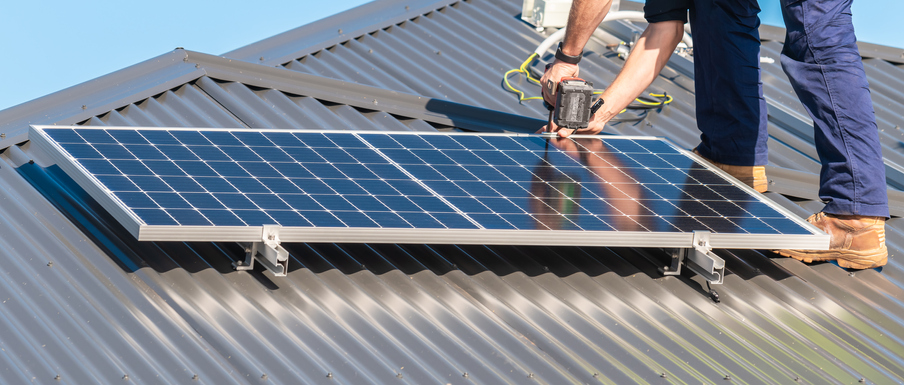What Will Motivate More People to Make Their Homes More Energy Efficient?
Researchers find that certain kinds of financial incentives are more effective than others
How do you get people to reduce their home’s carbon footprint?
The U.S. government hopes the answer is to appeal to their pocketbooks. As part of the Inflation Reduction Act, the government is rolling out increased federal tax credits and rebates to help offset the cost of energy-efficient upgrades such as electric heat pumps and added insulation, and adoption of clean-energy technologies such as rooftop solar.
But recent research suggests that some financial incentives might be more effective than others when it comes to getting middle- and lower-income consumers to make energy upgrades. Researchers also have found that social pressure can be effective: Consumers notice what their neighbors do, and energy providers might be able to leverage that to get people to make changes, researchers say.
Here is a closer look at what researchers have found that does and doesn’t work:
Money makes a difference—sometimes
One concern about many clean-energy tax credits is that historically they have disproportionately benefited the rich. Researchers say wealthier people are more likely to live in single-family homes, where it is easier to install things like rooftop solar and charge electric cars. It also could be that lower-income families have much lower taxes and thus benefit less from these kinds of tax breaks. So for many households, tax credits don’t talk.
But recent research from Lucas Davis, a professor at the University of California, Berkeley’s Haas School of Business, suggests that one of the enhanced energy tax credits in the Inflation Reduction Act could prove to be an exception to this rule.
In a study published this year, Davis and his co-authors found that 14% of U.S. households have a heat pump as their primary heating equipment, and that adoption levels are remarkably similar across different income levels, and even between homeowners and renters. Heat pumps often cost less than installing separate heating and cooling systems. And states with low electricity prices tend to have more heat-pump users since they cost less to operate in those areas.
Those findings suggest that the federal tax credit for purchasing and installing a heat pump—which increased to $2,000 from $300—has the potential to be more widely distributed across income levels than subsidies for many other low-carbon technologies, says Davis, and consequently get more people to invest in the equipment.
Another recent study looked at residential solar-adoption trajectories and why some communities lag behind others. The authors used satellite imagery and computer vision to capture the year-over-year growth of residential solar panels in 46 states between 2006 and 2017. They then looked at what the federal, state and municipal incentives were in place when the panels were installed.
They found that performance-based incentives—payments made to solar-panel owners based on how much electricity their system generates over a certain period—were associated with higher solar adoption rates in lower-income and middle-income communities than incentives tied to property taxes or rebates paid via lower state or municipal taxes.
In some cases, consumers can benefit from both performance-based incentives and net-metering programs, where homeowners can sell back to the utility any surplus power their solar system produces on sunny days, and use those credits to offset the cost of the power they pull from the grid at night or on cloudy days, resulting in a lower electric bill.
“Performance-based incentives reduce the upfront costs of solar panels for homeowners,” says Ram Rajagopal, an associate professor at Stanford University and one of the paper’s co-authors, explaining that if solar installers collect the performance-based incentives, homeowners can lease the panels at a discounted rate and still get the benefit of saving on their monthly electric bill.
A third recent study, meanwhile, finds that net metering and high electricity are two big factors that correlate with rooftop-solar adoption across the U.S. The authors conclude that anticipated electricity-cost savings could stimulate further solar deployment, especially in areas where people are skeptical about global warming, and should be incorporated into promotional campaigns.
Taken together, the recent studies suggest that when it comes to solar adoption, incentives that provide an immediate financial benefit—say, lower upfront installation costs and savings on electricity bills—could be more motivating to low- and middle-income households than tax credits they have to wait to collect.
Keeping up with the Joneses
Researchers also are examining whether social networks and connections can be leveraged to convince more households to make energy upgrades.
“Social norms and interactions affect people’s behaviour, and alternative energy is no exception,” says Kenneth Gillingham, a professor of economics and senior associate dean at Yale School of the Environment, whose work suggests solar-panel adoptions tend to happen in regional or geographic clusters.
Among Gillingham’s findings are that households are more likely to install solar panels if they can see their neighbours’ solar panels from the road. A forthcoming study of his finds that solar-panel installers are likely to reduce prices for customers whose homes are in centralised locations, since their installation is likely to encourage others to follow suit.
Researchers also are studying if the neighbour effect can be used to recruit households in lower-income communities for state and municipal programs that offer free home-energy audits or subsidised solar-panel installations.
The administrators of such programs often struggle to identify which households are eligible. And potential customers often lack key information, are turned off by the paperwork or don’t trust program providers, says Kim Wolske, a research associate professor at the University of Chicago’s Harris School of Public Policy.
“Even when the energy upgrades are free, past research suggests it can be difficult to recruit lower-income households,” she says.
In a recent study, Wolske and her co-authors asked 7,680 low-income homeowners who recently received free installation of solar panels if they could refer other potential customers.
To identify the best approach, the authors divided homeowners into three groups. The control group received a postcard saying they could get $200 for every referral that signed up for solar panels. The second group received that same offer plus a $1 thank-you gift, designed to remind them of the value of the installed solar panels (about $20,000) and to encourage them to return the kindness by referring another homeowner. The third group received the $200 offer, the $1 gift and a form where three referrals could be made along with a stamped and addressed envelope.
The researchers found that homeowners in the third group, who received the stamped and addressed envelope, were 7.5 times as likely to make referrals than the control group, and those referrals were 5.2 times as likely to result in a new solar contract.
How do you compare?
Energy providers, meanwhile, are testing whether they can nudge homeowners to make energy-efficiency improvements by comparing their energy use with that of neighbours.
Not only do such home-energy reports coax people into changing their behavior—say, turning off unused lights or turning down the heat—they also encourage people to make energy-efficient updates in their home, like buying Energy Star appliances, research shows.
A study published in 2022 found that energy consumption in homes that received a home-energy report remained low even after utilities stopped sending the reports and the owners sold the home, suggesting that the long-lasting benefits of these programs come from energy-efficient upgrades.
Another study in Southern California looked at the effect of sending home-energy reports and an additional nudge, called a peak energy report. Peak energy reports are automated phone calls or emails, reminding energy customers to reduce energy consumption during peak hours when demand for electricity exceeds supply.
The researchers found that when customers received both the home energy report and the peak-energy nudge, they reduced their electricity consumption on average by about 6.8%. Customers who received just one of the nudges also reduced their consumption but less so.
“Comparing customers provides a reference for energy usage and taps into their social consciousness,” says Robert Metcalfe, an associate professor of economics at the University of Southern California and author of the two studies on nudges.
 Copyright 2020, Dow Jones & Company, Inc. All Rights Reserved Worldwide. LEARN MORE
Copyright 2020, Dow Jones & Company, Inc. All Rights Reserved Worldwide. LEARN MORE
This stylish family home combines a classic palette and finishes with a flexible floorplan
Just 55 minutes from Sydney, make this your creative getaway located in the majestic Hawkesbury region.
Ahead of the Games, a breakdown of the city’s most desirable places to live
PARIS —Paris has long been a byword for luxurious living. The traditional components of the upscale home, from parquet floors to elaborate moldings, have their origins here. Yet settling down in just the right address in this low-rise, high-density city may be the greatest luxury of all.
Tradition reigns supreme in Paris real estate, where certain conditions seem set in stone—the western half of the city, on either side of the Seine, has long been more expensive than the east. But in the fashion world’s capital, parts of the housing market are also subject to shifting fads. In the trendy, hilly northeast, a roving cool factor can send prices in this year’s hip neighborhood rising, while last year’s might seem like a sudden bargain.
This week, with the opening of the Olympic Games and the eyes of the world turned toward Paris, The Wall Street Journal looks at the most expensive and desirable areas in the City of Light.
The Most Expensive Arrondissement: the 6th
Known for historic architecture, elegant apartment houses and bohemian street cred, the 6th Arrondissement is Paris’s answer to Manhattan’s West Village. Like its New York counterpart, the 6th’s starving-artist days are long behind it. But the charm that first wooed notable residents like Gertrude Stein and Jean-Paul Sartre is still largely intact, attracting high-minded tourists and deep-pocketed homeowners who can afford its once-edgy, now serene atmosphere.
Le Breton George V Notaires, a Paris notary with an international clientele, says the 6th consistently holds the title of most expensive arrondissement among Paris’s 20 administrative districts, and 2023 was no exception. Last year, average home prices reached $1,428 a square foot—almost 30% higher than the Paris average of $1,100 a square foot.
According to Meilleurs Agents, the Paris real estate appraisal company, the 6th is also home to three of the city’s five most expensive streets. Rue de Furstemberg, a secluded loop between Boulevard Saint-Germain and the Seine, comes in on top, with average prices of $2,454 a square foot as of March 2024.
For more than two decades, Kyle Branum, a 51-year-old attorney, and Kimberly Branum, a 60-year-old retired CEO, have been regular visitors to Paris, opting for apartment rentals and ultimately an ownership interest in an apartment in the city’s 7th Arrondissement, a sedate Left Bank district known for its discreet atmosphere and plutocratic residents.
“The 7th was the only place we stayed,” says Kimberly, “but we spent most of our time in the 6th.”
In 2022, inspired by the strength of the dollar, the Branums decided to fulfil a longstanding dream of buying in Paris. Working with Paris Property Group, they opted for a 1,465-square-foot, three-bedroom in a building dating to the 17th century on a side street in the 6th Arrondissement. They paid $2.7 million for the unit and then spent just over $1 million on the renovation, working with Franco-American visual artist Monte Laster, who also does interiors.
The couple, who live in Santa Barbara, Calif., plan to spend about three months a year in Paris, hosting children and grandchildren, and cooking after forays to local food markets. Their new kitchen, which includes a French stove from luxury appliance brand Lacanche, is Kimberly’s favourite room, she says.
Another American, investor Ashley Maddox, 49, is also considering relocating.
In 2012, the longtime Paris resident bought a dingy, overstuffed 1,765-square-foot apartment in the 6th and started from scratch. She paid $2.5 million and undertook a gut renovation and building improvements for about $800,000. A centrepiece of the home now is the one-time salon, which was turned into an open-plan kitchen and dining area where Maddox and her three children tend to hang out, American-style. Just outside her door are some of the city’s best-known bakeries and cheesemongers, and she is a short walk from the Jardin du Luxembourg, the Left Bank’s premier green space.
“A lot of the majesty of the city is accessible from here,” she says. “It’s so central, it’s bananas.” Now that two of her children are going away to school, she has listed the four-bedroom apartment with Varenne for $5 million.
The Most Expensive Neighbourhoods: Notre-Dame and Invalides
Garrow Kedigian is moving up in the world of Parisian real estate by heading south of the Seine.
During the pandemic, the Canada-born, New York-based interior designer reassessed his life, he says, and decided “I’m not going to wait any longer to have a pied-à-terre in Paris.”
He originally selected a 1,130-square-foot one-bedroom in the trendy 9th Arrondissement, an up-and-coming Right Bank district just below Montmartre. But he soon realised it was too small for his extended stays, not to mention hosting guests from out of town.
After paying about $1.6 million in 2022 and then investing about $55,000 in new decor, he put the unit up for sale in early 2024 and went house-shopping a second time. He ended up in the Invalides quarter of the 7th Arrondissement in the shadow of one Paris’s signature monuments, the golden-domed Hôtel des Invalides, which dates to the 17th century and is fronted by a grand esplanade.
His new neighbourhood vies for Paris’s most expensive with the Notre-Dame quarter in the 4th Arrondissement, centred on a few islands in the Seine behind its namesake cathedral. According to Le Breton, home prices in the Notre-Dame neighbourhood were $1,818 a square foot in 2023, followed by $1,568 a square foot in Invalides.
After breaking even on his Right Bank one-bedroom, Kedigian paid $2.4 million for his new 1,450-square-foot two-bedroom in a late 19th-century building. It has southern exposures, rounded living-room windows and “gorgeous floors,” he says. Kedigian, who bought the new flat through Junot Fine Properties/Knight Frank, plans to spend up to $435,000 on a renovation that will involve restoring the original 12-foot ceiling height in many of the rooms, as well as rescuing the ceilings’ elaborate stucco detailing. He expects to finish in 2025.
Over in the Notre-Dame neighbourhood, Belles demeures de France/Christie’s recently sold a 2,370-square-foot, four-bedroom home for close to the asking price of about $8.6 million, or about $3,630 a square foot. Listing agent Marie-Hélène Lundgreen says this places the unit near the very top of Paris luxury real estate, where prime homes typically sell between $2,530 and $4,040 a square foot.
The Most Expensive Suburb: Neuilly-sur-Seine
The Boulevard Périphérique, the 22-mile ring road that surrounds Paris and its 20 arrondissements, was once a line in the sand for Parisians, who regarded the French capital’s numerous suburbs as something to drive through on their way to and from vacation. The past few decades have seen waves of gentrification beyond the city’s borders, upgrading humble or industrial districts to the north and east into prime residential areas. And it has turned Neuilly-sur-Seine, just northwest of the city, into a luxury compound of first resort.
In 2023, Neuilly’s average home price of $1,092 a square foot made the leafy, stately community Paris’s most expensive suburb.
Longtime residents, Alain and Michèle Bigio, decided this year is the right time to list their 7,730-square-foot, four-bedroom townhouse on a gated Neuilly street.
The couple, now in their mid 70s, completed the home in 1990, two years after they purchased a small parcel of garden from the owners next door for an undisclosed amount. Having relocated from a white-marble château outside Paris, the couple echoed their previous home by using white- and cream-coloured stone in the new four-story build. The Bigios, who will relocate just back over the border in the 16th Arrondissement, have listed the property with Emile Garcin Propriétés for $14.7 million.
The couple raised two adult children here and undertook upgrades in their empty-nester years—most recently, an indoor pool in the basement and a new elevator.
The cool, pale interiors give way to dark and sardonic images in the former staff’s quarters in the basement where Alain works on his hobby—surreal and satirical paintings, whose risqué content means that his wife prefers they stay downstairs. “I’m not a painter,” he says. “But I paint.”
The Trendiest Arrondissement: the 9th
French interior designer Julie Hamon is theatre royalty. Her grandfather was playwright Jean Anouilh, a giant of 20th-century French literature, and her sister is actress Gwendoline Hamon. The 52-year-old, who divides her time between Paris and the U.K., still remembers when the city’s 9th Arrondissement, where she and her husband bought their 1,885-square-foot duplex in 2017, was a place to have fun rather than put down roots. Now, the 9th is the place to do both.
The 9th, a largely 19th-century district, is Paris at its most urban. But what it lacks in parks and other green spaces, it makes up with nightlife and a bustling street life. Among Paris’s gentrifying districts, which have been transformed since 2000 from near-slums to the brink of luxury, the 9th has emerged as the clear winner. According to Le Breton, average 2023 home prices here were $1,062 a square foot, while its nearest competitors for the cool crown, the 10th and the 11th, have yet to break $1,011 a square foot.
A co-principal in the Bobo Design Studio, Hamon—whose gut renovation includes a dramatic skylight, a home cinema and air conditioning—still seems surprised at how far her arrondissement has come. “The 9th used to be well known for all the theatres, nightclubs and strip clubs,” she says. “But it was never a place where you wanted to live—now it’s the place to be.”
With their youngest child about to go to college, she and her husband, 52-year-old entrepreneur Guillaume Clignet, decided to list their Paris home for $3.45 million and live in London full-time. Propriétés Parisiennes/Sotheby’s is handling the listing, which has just gone into contract after about six months on the market.
The 9th’s music venues were a draw for 44-year-old American musician and piano dealer, Ronen Segev, who divides his time between Miami and a 1,725-square-foot, two-bedroom in the lower reaches of the arrondissement. Aided by Paris Property Group, Segev purchased the apartment at auction during the pandemic, sight unseen, for $1.69 million. He spent $270,000 on a renovation, knocking down a wall to make a larger salon suitable for home concerts.
During the Olympics, Segev is renting out the space for about $22,850 a week to attendees of the Games. Otherwise, he prefers longer-term sublets to visiting musicians for $32,700 a month.
Most Exclusive Address: Avenue Junot
Hidden in the hilly expanses of the 18th Arrondissement lies a legendary street that, for those in the know, is the city’s most exclusive address. Avenue Junot, a bucolic tree-lined lane, is a fairy-tale version of the city, separate from the gritty bustle that surrounds it.
Homes here rarely come up for sale, and, when they do, they tend to be off-market, or sold before they can be listed. Martine Kuperfis—whose Paris-based Junot Group real-estate company is named for the street—says the most expensive units here are penthouses with views over the whole of the city.
In 2021, her agency sold a 3,230-square-foot triplex apartment, with a 1,400-square-foot terrace, for $8.5 million. At about $2,630 a square foot, that is three times the current average price in the whole of the 18th.
Among its current Junot listings is a 1930s 1,220-square-foot townhouse on the avenue’s cobblestone extension, with an asking price of $2.8 million.
This stylish family home combines a classic palette and finishes with a flexible floorplan
Just 55 minutes from Sydney, make this your creative getaway located in the majestic Hawkesbury region.






















